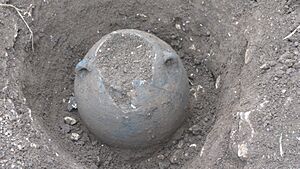Wold Newton Hoard facts for kids
Quick facts for kids Wold Newton hoard |
|
|---|---|

Wold Newton hoard as it was found
|
|
| Material | Roman coins Roman pottery |
| Size | 1,857 coins |
| Created | 294-307 |
| Period/culture | Romano-British |
| Discovered | 2014 Wold Newton, East Riding of Yorkshire England |
| Present location | Yorkshire Museum, York |
The Wold Newton Hoard is a special collection of ancient coins. It was found hidden in a pottery pot. This amazing treasure dates back to the early 300s AD. There are 1,857 coins in total! Today, you can see it at the Yorkshire Museum. The museum bought it in 2016.
Contents
Finding the Ancient Treasure
This incredible coin hoard was discovered by David Blakely. He was using a metal detector. On September 21, 2014, he found it in a field. The field was near a village called Wold Newton. This area is in the East Riding of Yorkshire in England.
What Was Inside the Hoard?
The Wold Newton Hoard holds 1,857 coins. Most of these coins are made of copper alloy. They are called nummi. These nummi coins were made between 294 AD and 307 AD. There was also one older coin. It was a radiate coin from 268 AD to 270 AD.
The coins were carefully placed inside a grey pottery jar. This jar was made around the 4th century. Next to the jar, parts of a dish were found. There were also other pieces of pottery. One of these pieces might have been used as a lid for the coin pot.
Why This Hoard Is Special
The Wold Newton Hoard is very important. It is the biggest Roman coin hoard of its kind. No other hoard like it has ever been found in the north of England. It helps us learn more about Roman times in Britain.
Bringing the Hoard to the Museum
After it was found, the hoard was declared a "treasure." This means it's very important to the country. Experts valued the hoard at over £44,200.
The Yorkshire Museum wanted to buy this amazing treasure. They started a special fundraising campaign. This campaign began on July 25, 2016. Many people from all over the world donated money. The Arts Council and the Victoria and Albert Museum also gave £10,000. An American group, the American Friends of the Arts Fund, donated £9,981.
Thanks to all these donations, the museum bought the hoard. On June 1, 2017, the Wold Newton Hoard went on display. You can now see it at the Yorkshire Museum. It was shown as part of the York Roman Festival.

